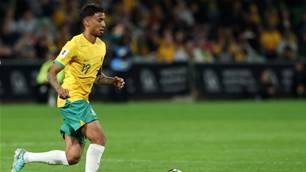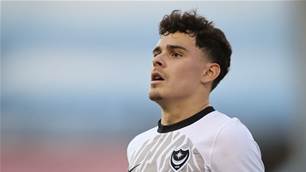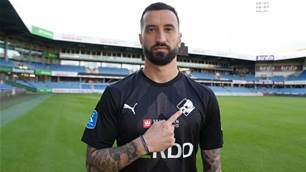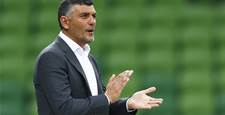FFA technical director Han Berger explains the progress of our National Curriculum.
AUSTRALIAN youth football used to be about results and strength. FFA technical director Han Berger explains how every level is now focused on technically gifted match-winners...
Tough, hard-working, dedicated, strong and determined to win. That could be the description of an Aussie footballer from any era. But success in modern football does not dictate to such a breed of player.
The top level club and country landscape is dominated by technically gifted, and often diminutive, ball-playing creators. In the third part of our youth development series, we speak with FFA technical director Han Berger about his blueprint for producing technically gifted players in Australia. There has been some vacillating interpretations from fans and the media of Berger’s plans, so here we set the record straight by presenting an unfettered account of his plans.
Berger oversees coach education and the implementation of a training and playing system for the country’s most talented youth footballers. The former Eredivisie, J.League and Netherlands U/23 and U/21 coach has also marshalled the development of the Dutch national youth system, and has an even taller task ahead of him in Australia now.
After his November 2008 appointment, taking over from countryman Rob Baan, one of Berger’s primary tasks was the development of the National Football Curriculum (NFC). The Curriculum was launched in May 2009 and has the long-term aim of improving the skill level, quality and performance of Australia’s top players and teams.
“Within five to ten years, there should be a clear difference with the current situation,” says Berger. “Regarding the coaching and training of young players, a mentality shift is needed and that’s not an easy thing to achieve. In Australia, from the earliest childhood, the focus lies on getting results – winning at all cost. That is the mentality of Australians and it is a positive characteristic. However, the consequence for youth football is that selections are made on physical characteristics. The biggest, strongest and fastest children are being identified, rather than looking for the most talented ones. This is reflected in the general style of play at youth level: launching the ball from the back and the physically strongest players making the difference to the result. It’s “fight-ball” rather than football.”
Berger explains that while the purpose of football is obviously about winning the game, at a younger age it is important to teach kids the proper game skills, which will give them a better chance to be successful when they reach senior level. He stresses that at top level, fitness and strength are not the decisive factors, citing the 2010 World Cup where the likes of Xavi, Özil, Iniesta, and Sneijder dominated. “In Australia, we need to produce better players instead of fitter players – that is the essence of the Curriculum. There has been too much focus in the past on developing athletes.”
Berger insists he is focused on building a football culture in Australia where the game is played all year round and there are plenty of opportunities for kids of every age to enjoy the game and develop themselves.
“The long-term objective of the Curriculum is to produce match-winning players,” says Berger. “Top level football today is about technical and tactical qualities. The top teams play a possession-based style of football and they all have a number of match-winning players who are able to decide games based on their outstanding technical qualities.
Fitness is not the decisive factor at the top, special players are. Fulfilling this aim is not going to be easy and it is not going to happen overnight. The Curriculum’s Building Blocks methodology is the framework that provides the practical guidelines for coaches working at all levels of youth development.” In other words: it explains what should be taught to players at various ages, from five all the way up to 20.
It starts when kids are between five and roughly 10 years-old with the ‘Discovery Phase’, where youngsters should simply “play football in a natural way”. “At this stage, there is little need for ‘coaching’,” says Berger. “Mimicking the ancient situation of street football is the best you can do. Many coaches make the mistake to structure training too much at this age. Just let these young kids play and discover what they can and cannot do with a ball. The game is the best teacher at this age, that’s why Brazilian and African players are technically so good: not because of their ‘system’ but because they’ve developed naturally.”
The next step between 10 and 13 years-old, is the ‘Skill Acquisition Phase’, where training becomes more structured and the emphasis is placed on developing a solid technical foundation. “This age is, in terms of physical and mental development of a child, the ideal period to develop motor skills,” explains Berger.
Between 13-16 years of age, the period of growth spurts and puberty, the emphasis is placed on learning to play as a team. FFA call this phase the ‘Game-training Phase’. Berger explains that the players are now mentally able to work together and to understand and execute both individual and team tasks. It is important that a coach who is working with players of this age is able to design ‘game-related’ training sessions in order to teach the players how to better solve the ‘football problems’ they encounter during the games.
The fourth phase, starts from about 16 onwards. The players have completed the growth spurt and are ready for competitive football. This ‘Performance Phase’ focuses on performing (and winning!) as a team in a competitive environment. “This is also the moment where fitness training is getting relevant, at least if it’s done in a football specific way,” says Berger. “In youth football in Australia a lot of valuable training time is wasted on non football-specific, irrelevant so-called strength and conditioning training that sometimes even is detrimental for children’s health.”
Throughout each of these phases the game format gradually changes: “up to seven years-old the game is played four-versus-four, the eight and nine-year-olds play seven-versus-seven and the 10 and 11-year-olds play nine-versus-nine – obviously on an increasingly large playing field,” says Berger. “From there we switch to 11-versus-11 on the big field.
These so-called Small Sided Game formats are still not generally accepted everywhere in Australia, which I find amazing because everywhere else in the world of football people understand the rationale of this. Football is a complicated game where players have to constantly make decisions. The bigger the numbers and distances, the more complicated the game. With smaller numbers and pitches the game is less complicated, kids get more touches on the ball and therefore the game is more fun. If you want to teach a child how to swim, you also would not throw it straight into the two-metre deep Olympic pool, would you?”
As kids play this brand of Small Sided Football, the emphasis again should not be focused on results. While Berger acknowledges that the purpose of football is to win games, youth football should not be about winning at all costs. There is a recommendation not to keep rankings and play for championships until the age of 12 at the very earliest, but Berger concedes this is a “very sensitive matter”.
While the theory and structure is established, the implementation in a vast and diverse Australia is the core of Berger’s challenge. “I’m sorry to say it, but the general level of youth coaching in Australia is still very poor. A lot of valuable training time is wasted on irrelevant, non-football content,” says Berger. “Training pitches are filled with hurdles and ladders and so-called youth coaches run the kids around the pitch. This disguises their inability to teach kids the proper game skills and they get away with it because the majority of parents lack football knowledge. Because of this FFA has created a development pathway for the most talented 10 to 18-years-old players. Within this pathway we apply the principles of the National Curriculum and the Building Blocks methodology.”
The ‘Discovery Phase’ – the first Building Block for kids between five and roughly 10 years-old – is all about grassroots and small-sided football. “There are no national programs for this age and neither should there be,” explains Berger. “Kids this age should just play and enjoy the game. We are aware that we need to improve the level of grassroots coaching which we try to do through our free-of-charge community coaching courses and state coaching conferences. We will also introduce community skill acquisition coaching courses in the near future too.”
Continues on next page...
Last year FFA started Skill Acquisition Programs for talented 10-13 year-old boys and girls in every state and territory. The pinnacle of these programs were the ‘Skilleroos’ squads where the most talented U/13 kids train and play under the guidance of FFA-trained expert skill coaches in a year-round, free-of-charge elite program. Unfortunately the awareness of the Skill Acquisition Programs, especially among parents, still has to improve dramatically. “Parents would rather pay thousands of dollars to send their kids to so-called elite academies instead of sending them our programs that deliver real quality, for free.”
These Skill Acquisition Programs underpin and lead into the next phase – the State Institute Programs. These are programs aimed at the best 14-16 year-old boys and are also year-round and free of charge. The coaches involved are trained and selected by FFA and the Game Training Phase is covered by these programs: teaching the players the individual team tasks and how these tasks link together when you play as a team.
In conjunction with the various Member Federations, FFA have appointed State Technical Directors to oversee and guide the whole process. “Previously scouting was focused on identifying and selecting big, fast and strong players,” says Berger. “This has caused a major problem in Australia called the “Relative Age Effect” – where players born in the first months of the year are selected as they are more developed physically.
This undoubtedly results in us losing many potentially talented players from a player pool that already isn’t very large. The coaches who work in the national programs have now been instructed to first look for skilful players. Physical shortcomings can always be refined later and appear not to be the determining factor at the top anyway.”
The next ‘Performance Phase’ takes place at the Australian Institute of Sport (AIS) in Canberra. The AIS football program is a full-time residential program for the very best Australian U/17 players. The majority of Australia’s U/17 team, the Joeys, are in this program and they play as a team in the National Youth League. For many of the AIS graduates this pathway is the start of a professional career, with several inking professional contracts with A-League or European clubs every year.
“Nationally, there is now a clear pathway for talented boys, in which the various steps are logically linked,” says Berger. “Access to any of these programs should not be money-driven – it should be about every talented kid getting the opportunity to enter these programs.” For the girls the pathway is different and not that streamlined yet. Berger claims FFA are currently working hard to improve this, because the interest among girls and women in football has increased dramatically.
“We also are aware that the number of available places in this pathway is too limited and needs to be increased,” says Berger. “FFA is working on a number of initiatives to make that happen, in particular an accreditation system for A-league and state league club youth development academies.”
While the above lays out the pathway for young Aussies players, there is a second element to Berger’s Curriculum – coach education. “Via the programs of the National Talented Player Pathway we can only influence a very limited number of players,” says Berger. “A better education of coaches at all levels of the game is the most effective way to bring about the desired changes and improvements throughout the whole football community.
“This is a long-term process and we should be thinking in decades rather than years. We have totally reviewed and restructured coach education across Australia. The content of the coaching courses has totally changed, our courses now match the standard of world’s best practice, I dare say.” The Asian Football Confederation (AFC) recently signed off on an agreement which allows FFA to run their own, AFC-approved, advanced coaching courses. From 46 AFC member federations only Japan and Australia have been granted this right, due to the standard and quality of their coach education programs.
In Australia there are two coaching pathways – the community coaching pathway, which is aimed at volunteers, parents and anyone working at the grassroots level, where the courses are free. The second pathway is the advanced coaching pathway, which starts at C-Licence level and moves onto B-Licence, A-Licence and finally the highest licence possible in football, the Pro Diploma. There are higher costs for the advanced coaching courses as they are aimed at those planning to make a living out of football coaching.
Despite criticism of the costs associated with the advanced coaching courses, Berger says that most career education involves a cost, and that FFA have taken measures to reduce the costs and improve the accessibility. “Until recently C-Licence courses were conducted in either Canberra or Sydney, now we run C-Licence courses in all member federations. We have a pool of instructors in each of the states who can deliver these courses. The same will be the case with the B-Licence courses, as soon as we have trained sufficient instructors. This makes coach education more accessible and less expensive as everyone can take a course close to home.”
To assist in the broadening of coaching knowledge across Australia’s vast geography, the National Coaching Conference, which traditionally took place annually in a major city, now encompasses a road trip-style Coaching Conference which visits every member federation across the country. “We offer a compact, refresher coaching course at these conferences,” says Berger.
He goes on to stress that the many of the fitness coaches involved in football in Australia come from other codes such as AFL and rugby. “Their fitness programs are often generic and not football-specific. This way we lose a lot of valuable football training time, while we need to improve technically and tactically. This is the reason the football conditioning methodology of Raymond Verheijen [interviewed in last month’s FourFourTwo] is now an integrated part of our A and Pro Licence courses,” says Berger.
When Berger joined FFA in 2008, five coaches in the A-League had only a B-level coaching licence. Today, an Australian coach in the A-League must at least hold an A-Licence and a foreigner needs to have a Pro Diploma. From 2015 a Pro Diploma will be compulsory for every head coach in the A-League.
One of the most controversial aspects of the Curriculum’s release in 2009 was the use of the Dutch-style 4-3-3 formation as standard at the various youth levels. Many were left concerned that our young players would develop only being able to play one formation. “The fact that a 4-3-3 formation was made compulsory for the Institute teams gave rise to many discussions and has led to a number of widespread misunderstandings,” says Berger. “Playing in a 4-3-3 formation is a ‘training tool’, particularly in the Game Training Phase. To learn to play together as a team at a young age, I am absolutely convinced that the 4-3-3 formation offers some clear advantages. However, the media ran off with it and suggested I wanted everybody in Australia, from the lowest to the highest level, to play 4-3-3.
“There are many successful formations and playing styles, but when it comes to learning to play as a team I undoubtedly prefer 4-3-3. The fact is that for youth players, the positions and the attached basic tasks of the 4-3-3 are clear, logical and recognisable.
“In the 4-3-3 formation there are three lines with a balanced spread of players over the pitch and ‘triangles’ of players. This creates a range of other, and more logical, options for young players. Rather than just kicking the ball forward, players almost “automatically” start making combinations. The 4-3-3 formation also stimulates the development of creative, match-winning players; more specifically the three attackers and the attacking midfielders and that’s what Australia desperately needs.”
While the implementation of the Curriculum and its Building Blocks many seem convincing in theory, Berger has faced several challenges since his arrival. “There are so many roadblocks coming from the game’s various “stakeholders” – associations, clubs, private academies, agents and schools – who too often operate with their own interests, like money, ego or power at the fore. When it comes to youth development, the interest of the players should be at the top of the list. The best players should train with each other and play against each other under the guidance of specialised youth development coaches. Many kids might be playing a lot of football, but the quality is important, not the quantity. We are convinced our programs deliver the best quality.”
Continues on next page...
Berger feels that in Australia, parents often lack the knowledge about what is best practice and what is in the interest of their kids. “When parents pay fortunes to academies and clubs, all they want to hear is how good their kid is and that they might get to an overseas club,” says Berger. “Many parents are focused on getting their kids overseas at the youngest possible age and this puts an unhealthy psychological pressure on the kids. Unfortunately in the media you only read the success stories, but for every success story there are a hundred, often very sad, stories of the ones who did not succeed. In addition many parents do not seem to be aware that FIFA rules do not allow young players to move overseas before they are 18 years-old.”
There is a traditional mentality in Australia that England, and its EPL, is the shining beacon that all young Aussie players should aspire towards. Berger outlines that recent research from England has suggested that the EPL academy system is light-years behind the likes of Holland and Spain. “Without wanting to make Australia a football colony of Holland, which is often the accusation I receive, it is not without a reason that the biggest league in the world is looking at the Dutch development system,” says Berger. “And of course I’ve used certain elements of the “Dutch school” in our Curriculum, combining them with the strong elements of the Australian sporting culture.
“It would be much better for the majority of young players to mature as a player in Australia before going overseas. When you already have first-team A-League experience, a young player will have a much better chance to succeed.
He will enter an overseas club with a higher ‘profile, will get a better contract and a better opportunity to get into the starting eleven. Players like Tommy Oar, Michael Zullo and Luke DeVere are good examples. This is also beneficial for the future of our national teams because now we see many talented players who go overseas too sit on the bench or in reserve teams.
“I really like to see young players given first-team chances in the A-League. In the A-League, many strikers and playmakers are foreigners, which is not really beneficial if we want to develop more ‘match-winning’ Australian players. Therefore, I advocate measures that would force clubs to only attract quality foreign players and not players who don’t add anything to the A-League. This way young talent hopefully gets the opportunities sooner, although I realise that for the A-League coaches their first priority is results.”
Young Aussie talent did have a chance to prove itself recently in the July FIFA U/17 World Cup in Mexico and the FIFA U/20 World Cup in Colombia the following month. In Mexico, the Joeys exited after a 4-0 defeat to Uzbekistan in the Round of 16, while in Colombia the Young Socceroos finished bottom of their group and lost 5-1 to Spain in their final game. The critics swooped to lambast the squads, coach Versleijen, plus Berger and the Curriculum.
“It is development versus results,” says Berger. “I was told the Joeys made the World Cup final in 1999, but only one player from that team is currently in the Socceroos. What then is the long-term value of that achievement? The Australian mentality is about winning at all costs, while the Dutch approach is about development – the results will come later when it really matters. At those recent youth World Cups the Dutch Under-17s, who are the reigning European champions, crashed in the group stage and the Under-20s did not even qualify. But nobody, including the media, really made a point of this because everybody knows that the system is consistently producing top level players. Because of that, Holland, as a small country, has been for decades a power in world football.”
Berger highlighted that the current Australian youth development process started only two years ago. “Anyone who understands the complexity of such a process knows that it will take time before we will see the changes and improvements. For opportunists it is very easy to criticise the system or the coach based on the youth World Cup performances.
“The Joeys finished 15th in the U/17 World Cup and the Young Socceroos finished 19th which is very much in line with the current position of the Socceroos on the FIFA ranking. So that’s obviously our current position in world football and to be honest, I think that’s quite good,” says Berger. “We should realise that, whether we like it or not, football in Australia is still developing. We do not yet have the football culture of the European and South American nations who we have to compete with at such tournaments. They play football all year round, every day, all day – for them it is a way of life.”
Berger continues that the level at those recent World Cups is higher than the youngsters would have been used to – while the Joeys played as the AIS in the National Youth League last year and fared well. “They were able to dominate and win many games playing the technically sound, possession-based style of football we promote,” says Berger. “Of course at the World Cup they tried to play the type of football they had played all year, but the quality of opposition was so much higher that they simply couldn’t.
I don’t want to sound defensive because there were also lots of positives. Technically we are improving, the FIFA technical report of the U/17 World Cup underlined this. Our teams were among the youngest in both the U/17 and U/20 World Cups because our selection process was based on technical qualities instead of physical qualities. Because of this approach you might lose on the short-term but I’m convinced we will win on the long-term. And, most importantly, there were individual players that stood out in both teams, like Connor Chapman and Dylan Tombidis in the Joeys and Terry Antonis, Tommy Oar and Kerem Bulut in the Young Socceroos. Of course we have also critically evaluated both tournaments and identified key points of improvement that we’ve already started working on,” adds Berger.
The reaction to the performances at the U/17 and U/20 World Cups not only highlighted that educating fans on the FFA ethos of “development over results” is going to be a long slog for Berger and his Curriculum. But it was also a sobering reminder that fostering a culture and environment, so we can produce match-winning players, is a long road too. One that we hope, with enough time, will be filling our Socceroos squads for years to come.
This article appeared in the December 2011 issue of Australian FourFourTwo magazine. To buy back copies of this issue call 03-8317-8121 with a credit card to hand.
The current edition of Australian FourFourTwo has just gone on sale in newsagent across the country, or you can subscribe here
Related Articles

Socceroos midfielder embraces move to England

Cardiff City snap up sought-after Socceroos starlet













